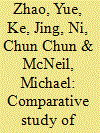|
|
|
Sort Order |
|
|
|
Items / Page
|
|
|
|
|
|
|
| Srl | Item |
| 1 |
ID:
107627


|
|
|
|
|
| Publication |
2011.
|
| Summary/Abstract |
China has implemented a series of minimum energy performance standards (MEPS) for over 30 appliances, voluntary energy efficiency label for 40 products, and a mandatory energy information label that covers 19 products to date. However, the impact of these programs and their savings potential has not been evaluated on a consistent basis. This paper uses modeling to estimate the energy saving and CO2 emission reduction potential of the appliances standard and labeling program for products for which standards are currently in place, under development or those proposed for development in 2010 under three scenarios that differ in the pace and stringency of MEPS development. In addition to a baseline "frozen efficiency" scenario at 2009 MEPS level, the "Continued Improvement Scenario" (CIS) reflects the likely pace of post-2009 MEPS revisions, and the likely improvement at each revision step. The "Best Practice Scenario" (BPS) examined the potential of an achievement of international best-practice efficiency in broad commercial use today in 2014. This paper concludes that under "CIS", cumulative electricity consumption could be reduced by 9503 TWh, and annual CO2 emissions of energy used for all 37 products would be 16% lower than in the frozen efficiency scenario. Under a "BPS" scenario for a subset of products, cumulative electricity savings would be 5450 TWh and annual CO2 emissions reduction of energy used for 11 appliances would be 35% lower.
|
|
|
|
|
|
|
|
|
|
|
|
|
|
|
|
| 2 |
ID:
132746


|
|
|
|
|
| Publication |
2014.
|
| Summary/Abstract |
The industrial sector consumes about 50% of the world×s delivered energy and thus has a large impact on the world×s energy production and consumption. Japan is one of the leading countries in industrial efficiency while China is the world×s largest industrial energy consumer. This study analyzes the energy consumption and efficiency of the Japanese and Chinese manufacturing industry. Analysis shows that the energy intensity of both Japanese and Chinese manufacturing industry has decreased significantly. Decomposition analysis shows that the efficiency effect played an important role in reducing energy intensity; improvement of the energy efficiency of both Japanese and Chinese manufacturing industry showed a trend of exponential decay. Structural effect significantly reduced the energy intensity of the Japanese manufacturing industry while having a relatively small influence on the energy intensity of the Chinese manufacturing industry. Our analysis also shows a strong association of industrial energy efficiency improvement with energy policies, highlighting that energy efficiency policies can play an important role in the reduction of industrial energy intensity. The results of this study also underscore the important, yet very challenging, task of achieving structural change to further improve efficiency.
|
|
|
|
|
|
|
|
|
|
|
|
|
|
|
|
| 3 |
ID:
121353


|
|
|
|
|
| Publication |
2013.
|
| Summary/Abstract |
In 2010, China's cement output was 1.9 Gt, which accounted for 56% of world cement production. Total carbon dioxide (CO2) emissions from Chinese cement production could therefore exceed 1.2 Gt. The magnitude of emissions from this single industrial sector in one country underscores the need to understand the uncertainty of current estimates of cement emissions in China. This paper compares several methodologies for calculating CO2 emissions from cement production, including the three main components of emissions: direct emissions from the calcination process for clinker production, direct emissions from fossil fuel combustion and indirect emissions from electricity consumption. This paper examines in detail the differences between common methodologies for each emission component, and considers their effect on total emissions. We then evaluate the overall level of uncertainty implied by the differences among methodologies according to recommendations of the Joint Committee for Guides in Metrology. We find a relative uncertainty in China's cement-related emissions in the range of 10 to 18%. This result highlights the importance of understanding and refining methods of estimating emissions in this important industrial sector.
|
|
|
|
|
|
|
|
|
|
|
|
|
|
|
|
|
|
|
|
|